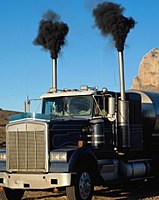
Photo from wikipedia
Abstract The aim of the present work is to investigate the effect of low-flow-rate injection of silver-water nanofluid on the enhancement of thermal and radiative characteristics and reduction of NOx… Click to show full abstract
Abstract The aim of the present work is to investigate the effect of low-flow-rate injection of silver-water nanofluid on the enhancement of thermal and radiative characteristics and reduction of NOx emission in natural gas flame. In our method, 0.009 Lit/min of 100-ppm silver-water nanofluid is directly injected into the natural gas flame at the equivalence ratio of 0.65. An SBG01 water cooled heat flux sensor is used to measure the total radiation of flame and IR photography method and luminosity measurement are used to determine the spectral emissivity of flame in infrared and visible wavelengths. Furthermore, a KIGAS 310 gas analyzer measures the concentrations of pollutant emissions. The results indicate that nanofluid injection enhances the IR radiation of natural gas flame and creates a high-value and uniform radiative heat flux distribution for flame. Solid nanoparticles, as foreign surfaces, enhance the nucleation rate and surface growth of soot particles, which are the best radiative species in flame. The other parameters which affect the flame radiation are increase in H2O concentration, as another radiative species, and increased number of tiny high temperature dark nanoparticles, as highly emissive bodies. Furthermore, although the nanofluid injection does not significantly change the concentration of carbonaceous pollutant emission, it decreases the NOx emission as much as 22.6%. The reduction of NOx emission is caused by decrease in the maximum flame temperature, due to absorption of heat by nanofluid droplets, and increase in the concentration of OH radicals, due to dissociation of H2O at the high temperatures of flame reaction zone.
Journal Title: Energy
Year Published: 2020
Link to full text (if available)
Share on Social Media: Sign Up to like & get
recommendations!